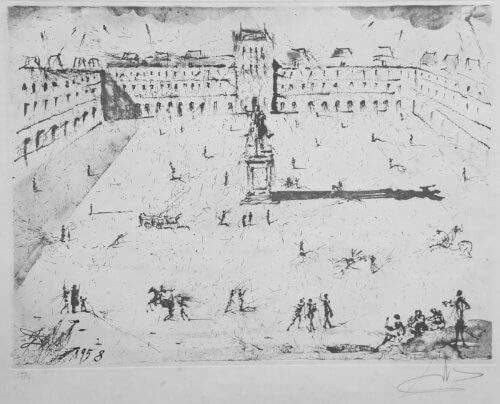Salvador Dali. Vosges square (1958)
Salvador Dali is a Spanish artist whose name is definitely associated with surrealism. Then he made his contribution to this cultural direction in almost all possible manifestations: painting, sculpture, architecture, cinematography, theater, book illustration, logo design, clothing and window dressing. With his own outrageousness, as well as the bright and recognizable style of works designed to illustrate the processes in the Unconscious, Dali earned himself insane fame and financial success. And not only in Europe, but also in the United States of America, where he was stationed during the Spanish Civil War and World War II.
The beginning of the artist's career and the last 30 years of his life were spent in the Spanish Catalonia. After returning from the USA in 1948, he settled on the coast of Cadaques, his favorite since childhood. During the next decade, Dali admired the achievements of science, pondered over religious issues, experimented with optical illusions, and often referred to the achievements of Renaissance artists.

At first glance, Vosges square is not at all similar to the vivid surrealistic canvases of Dalí that the viewer is used to. Only intricate and at the same time very apt lines, elongated shadows allow you to recognize the hand of the master in the work.
This etching print* is made on a sheet of paper measuring 57 x 59 cm. The copy from the collection of the Mystetskyi Arsenal is the 44th out of 150 in existence. The number is important, because the closer the print is to the first 20, the more valuable it is considered to be. In front of us is a square of rectangular shape, framed by three- and four-story palace buildings. In the center of the square is an equestrian statue on a pedestal, and around it are scattered figurines of people passing by, some of them moving on horses or in carriages. It appears as if a group of people in the lower right corner are crouched down and resting. At first glance, the work may seem like a quick sketch, where, despite the large number of small objects, no particular attention is paid to details. At the same time, using a linear and aerial perspective, the artist perfectly conveys the space, allows us to better see the foreground, and harmoniously fits the massive buildings behind into the overall composition.
The picture Vosges square by Salvador Dali was animated by Pause to Play animation studio.
Created as part of the Living Collection project
The Vosges square exists in Paris and is now, however, transformed into a garden. In the center is the same statue of Louis XIII on horseback, which was depicted by Dalí. It is interesting that the sculpture, commissioned by Cardinal Richelieu in the 17th century, was supposed to stop the duels that often took place in the square.
Dali and Paris were connected by a long history. One of the artist's first exhibition was held in this city, he met important people in his life: his muse and the love of his life Gala Eluard, a group of surrealists led by Andre Breton, cubist Pablo Picasso. It is known that in the year the work was created, Dalí gave lectures in one of the Parisian theaters and, as usual, could not help but surprise the audience. A loaf of bread about 12 meters long was baked before the lectures.
As for the etching itself, it entered Igor Dychenko's collection in the early 1990s. According to the collector's memories, the works were purchased by him in one of the Scandinavian countries.
*See more about etching techniques and other modern graphic techniques on our YouTube channel.